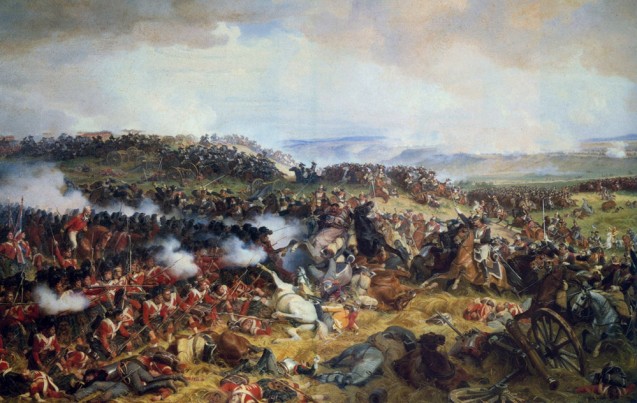The Battle of Waterloo has been debated for over two hundred years. On 18 June 1815, around thirty kilometres from Brussels, Napoleon’s army faced the Duke of Wellington and his British-led coalition army, which was reinforced by Blücher’s Prussian troops later in the battle.
At the start pf the battle, the situation was not in the least unfavourable to Napoleon. He had beaten the Prussians at Ligny two days earlier and believed that he had neutralised their threat by sending an army corps under Marshal Grouchy after them. So Napoleon marched into battle at Waterloo with a good chance of victory; with around 65,000 men he had roughly the same strength as his opponent. However, nothing went as he was expecting. A terrible storm broke during the night, and they had to wait until 11am the following day for the rain-soaked ground to dry out enough so as to enable the French army to get their artillery into position and to make that artillery effective. Worse still, Napoleon was ill – either haemorrhoids or dysuria (no-one knows for certain) – which affected his lucidity, something he really needed when faced with Wellington, an expert at defensive warfare. Napoleon’s plan was to turn Wellington’s forces at their weakest point (the left flank) having first pinned down his strongest point (the right flank), thereby forcing Wellington off the battlefield to the north-west and away from the Prussian forces. In the event, Wellington’s exceptionally well-planned defences, combined with the inefficiency of the French artillery and errors made by the French corps commanders, rendered this plan impossible. The combat became a full-frontal collision over a distance of less than five kilometres, and congestion on the battlefield meant that the manoeuvre could not be executed.
Early in the afternoon, Napoleon saw the Prussian troops in the distance, marching towards the battle. This time it was the French army’s right flank that was at risk of being turned. Napoleon knew he must defeat Wellington and his troops before Blücher arrived. As a result of an avalanche of misunderstandings, the entire French cavalry launched an attack, and Napoleon was powerless to stop it. Its ineffective charges hopelessly impaled themselves on Wellington’s defensive square formations. The Emperor continued to send reinforcements to the same spot, but they could only push the British and allied line back but not break it. This time it was the French who were “pinned down”. Prussian troops then came up behind the French position, and the French line broke. An extraordinary, unstoppable rout ensued. By 10 o’clock in the evening, it was all over; there were 10,800 dead (6,800 of which were French soldiers) and around 35,000 injured (of which two thirds were French), strewn across the “bleak plain”.
Though the battle was over, a new battle – fought entirely on paper – began immediately. Since then, there has been a continued debate as to whether or not Napoleon could have won; whether Ney had ‘betrayed’ him by sacrificing the cavalry (which he personally had led into battle), whether Grouchy should have arrived before Blücher, or whether Soult was a bad commander of headquarters (Berthier had died before the start of the campaign), etc.
One thing remains certain, however. Waterloo was one of the biggest military disasters ever suffered by a French army (before 1870), not only on the battlefield, but also because of its political consequences. Napoleon abdicated for the second time on 22 June 1815.


